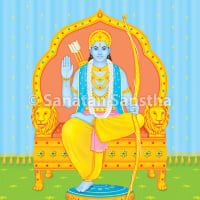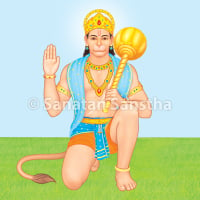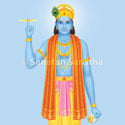Shri Ganapati Atharvashirsha was written by Atharva Rushi who had Ganapati Darshan. It is customary to invoke the name of Shri Ganesha before beginning anything. This page gives the meaning of Shri Ganapati Atharvashirsha.
Listen Audio
shrī gaṇēsha atharvashīrsham ।
shrī gaṇēshāya namaḥ ।
(shāntimantrāḥ)
oṃ bhadraṅ karṇēbhiḥ shṛṇuyāma dēvā bhadram pashyēmākshabhiryajatrāḥ ।
sthirairaṅgaistushṭuvāṃsastanūbhirvyashēma dēvahitaṃ yadāyuḥ ॥
oṃ svasti na indro vṛddhashravāḥ ।
svasti naḥ pūshā vishvavēdāḥ ।
svasti nastārkshyoऽarishṭanēmiḥ
svasti no bṛhaspatirdadhātu ॥
oṃ sahanāvavatu । sahanau bhunaktu । sahavīryaṅ karavāvahai ।
tējasvināvadhītamastu mā vidvishāvahai ॥
oṃ shāntiḥ shāntiḥ shāntiḥ ॥
(atha atharvashīrshārambhaḥ ।)
oṃ namastē gaṇapatayē ।
tvamēva pratyakshan tattvamasi ।
tvamēva kēvalaṅ kartāऽsi ।
tvamēva kēvalan dhartāऽsi ।
tvamēva kēvalaṃ hartāऽsi ।
tvamēva sarvaṅ khalvidam brahmāsi ।
tvaṃ sākshādātmāऽsi nityam ॥ 1 ॥
ṛtaṃ vachmi । satyaṃ vachmi ॥ 2 ॥
ava tvam mām । ava vaktāram ।
ava shrotāram । ava dātāram ।
ava dhātāram । avānūchānamava shishyam ।
ava pashchāttāt । ava purastāt ।
avottarāttāt । ava dakshiṇāttāt ।
ava chordhvāttāt । avādharāttāt ।
sarvato mām pāhi pāhi samantāt ॥ 3 ॥
tvaṃ vāṅmayastvañ chinmayaḥ ।
tvam ānandamayastvam brahmamayaḥ ।
tvaṃ sachchidānandādvitīyoऽsi ।
tvam pratyaksham brahmāsi ।
tvañ jñānamayo vijñānamayoऽsi ॥ 4 ॥
sarvañ jagadidan tvatto jāyatē ।
sarvañ jagadidan tvattastishṭhati ।
sarvañ jagadidan tvayi layamēshyati ।
sarvañ jagadidan tvayi pratyēti ।
tvam bhūmirāpoऽnaloऽnilo nabhaḥ ।
tvañ chatvāri vākpadāni ॥ 5 ॥
tvaṅ guṇatrayātītaḥ ।
(tvam avasthātrayātītaḥ ।)
tvan dēhatrayātītaḥ ।
tvaṅ kālatrayātītaḥ ।
tvam mūlādhārasthitoऽsi nityam ।
tvaṃ shaktitrayātmakaḥ ।
tvāṃ yogino dhyāyanti nityam ।
tvam brahmā tvaṃ vishṇustvaṃ rudrastvam
indrastvam agnistvaṃ vāyustvaṃ sūryastvañ
chandramāstvam brahmabhūrbhuvaḥ svarom ॥ 6 ॥
gaṇādim pūrvamuchchārya varṇādin tadanantaram ।
anusvāraḥ parataraḥ । ardhēndulasitam ।
tārēṇa ṛddham । ētattava manusvarūpam ।
gakāraḥ pūrvarūpam । akāro madhyamarūpam ।
anusvārashchāntyarūpam । binduruttararūpam ।
nādaḥ sandhānam । saṃhitā sandhiḥ ।
saishā gaṇēshavidyā । gaṇaka ṛshiḥ ।
nichṛdgāyatrīchchhandaḥ । gaṇapatirdēvatā ।
oṃ gam̐ gaṇapatayē namaḥ ॥ 7 ॥
ēkadantāya vidmahē । vakratuṇḍāya dhīmahi ।
tanno dantiḥ prachodayāt ॥ 8 ॥
ēkadantañ chaturhastam, pāshamaṅkushadhāriṇam ।
radañ cha varadaṃ hastairbibhrāṇam, mūshakadhvajam ।
raktaṃ lambodaram, shūrpakarṇakam, raktavāsasam ।
raktagandhānuliptāṅgam, raktapushpaiḥ supūjitam ।
bhaktānukampinan dēvañ, jagatkāraṇamachyutam ।
āvirbhūtañ cha sṛshṭyādau, prakṛtēḥ purushātparam ।
ēvan dhyāyati yo nityaṃ sa yogī yogināṃ varaḥ ॥ 9 ॥
namo vrātapatayē, namo gaṇapatayē, namaḥ pramathapatayē,
namastē astu lambodarāyaikadantāya, vighnanāshinē
shivasutāya, shrīvaradamūrtayē namaḥ ॥ 10 ॥
oṃ ētadatharvashīrshaṃ yoऽdhītē । sa brahmabhūyāya kalpatē ।
sa sarvavighnairna bādhyatē । sa sarvataḥ sukhamēdhatē ।
sa pañchamahāpāpāt pramuchyatē ।
sāyamadhīyāno divasakṛtam pāpan nāshayati ।
prātaradhīyāno rātrikṛtam pāpan nāshayati ।
sāyam prātaḥ prayuñjānoऽapāpo bhavati ।
sarvatrādhīyānoऽpavighno bhavati ।
dharmārthakāmamokshañ cha vindati ।
idam atharvashīrsham ashishyāya na dēyam ।
yo yadi mohāddāsyati sa pāpīyān bhavati ।
sahasrāvartanāt yaṃ yaṅ kāmamadhītē
tan tamanēna sādhayēt ॥ 11 ॥
anēna gaṇapatimabhishiñchati ।
sa vāgmī bhavati ।
chaturthyāmanashnan japati ।
sa vidyāvān bhavati ।
ityatharvaṇavākyam ।
brahmādyāvaraṇaṃ vidyāt ।
na bibhēti kadāchanēti ॥ 12 ॥
yo dūrvāṅkurairyajati । sa vaishravaṇopamo bhavati ।
yo lājairyajati, sa yashovān bhavati ।
sa mēdhāvān bhavati ।
yo modakasahasrēṇa yajati ।
sa vāñchhitaphalamavāpnoti ।
yaḥ sājyasamidbhiryajati ।
sa sarvaṃ labhatē, sa sarvaṃ labhatē ॥ 13 ॥
ashṭau brāhmaṇān samyaggrāhayitvā,
sūryavarchasvī bhavati ।
sūryagrahē mahānadyām pratimāsannidhau vā japtvā,
siddhamantro bhavati ।
mahāvighnāt pramuchyatē ।
mahādoshāt pramuchyatē ।
mahāpāpāt pramuchyatē ।
sa sarvavid bhavati, sa sarvavid bhavati ।
ya ēvaṃ vēda ॥ 14 ॥
ityupanishat ।
(shāntimantrāḥ)
oṃ bhadraṅ karṇēbhiḥ shṛṇuyāma dēvā bhadram pashyēmākshabhiryajatrāḥ ।
sthirairaṅgaistushṭuvāṃsastanūbhirvyashēma dēvahitaṃ yadāyuḥ ॥
oṃ svasti na indro vṛddhashravāḥ svasti naḥ pūshā vishvavēdāḥ ।
svasti nastārkshyoऽarishṭanēmiḥ svasti no bṛhaspatirdadhātu ॥
oṃ sahanāvavatu । saha nau bhunaktu । sahavīryaṅ karavāvahai ।
tējasvināvadhītamastu mā vidvishāvahai ॥
oṃ shāntiḥ shāntiḥ shāntiḥ ॥
Meaning of the stanzas
O Lord Ganesha
I Pay my deep homage to you, the Lord of the Deva-Gana
You are the first facet of the Bramha-Tatva to arise
You have alone created this entire universe
You alone can maintain this universe
You are indeed the all conquering supreme Lord
Indeed you are the “ATMA”
(Atharva Rushi) Speaks noble fact
(He) Speaks complete Truth
Protect me
Protect the one who describes you
Protect all who hear about your characteristics
Protect me & the disciples who are under tutelage
Protect me from the obstacles (which arise during Rituals)
From the east (similarly)
Protect me from the West,
From the North
From the South
Protect me from above & below
Protect me from all directions
You are the constituent of speech
You are Bliss & immortal consciousness
You are Truth, Mind & Bliss… one without a competitor
You are none other than divinity
You are Knowledge of gross & subtle types
All the Universes manifest due to you
All the Universes are sustained by you
All the Universes get destroyed in you
All the Universes finally get merged in you
You alone are Earth. Water, Fire, Air & Either
You are the 4 types of speech & the root source of sound
You are beyond the 3 ‘GUNAS’, (Satva; Pure, Rajas: Action & Tamas: Inertia)
You are beyond the 3 Bodies; (Gross, Subtle & Causal)
You are beyond Past, Present & Future (3 State of Time)
You are beyond 3 states of being; (Awake, dream & Deep Sleep)
You always Reside in the “MULADHARA” Chakra
You are the trinity of Power; (Creative Maintaining & Destructive Powers)
Sages always Meditate on you
You are the creator. Sustainer, Destroyer, The Lord of 3 worlds, Fire, Air, Sun, Moon, You are all inclusive & all Pervading
After Describing the Characteristics & Cosmic Attributes Of Lord Ganesha, Atharvan Rishi Gives us the Sacred “GANESH VIDYA” i.e. the Mantra which Reveals the Sacred Form of Lord Ganesh. The Letter “GA” is to be enunciated, following by “NA” This one word Mantra is then Potentiated with the “PRANAVA” “OM”. This is Sacred Mantra. (In order to make it Simpler, Atharvan Rishi Present the above easier FASHION, Remember that Knowledge was transmitted orally in those days.)
“GA” is the first part, “Na” is the middle & end “UM” formed by the bindu is conjoined with the foregoing & all of them form the Sacred word. This Mantra if pronounced properly, has the power of revaling The Divine Lord Ganesh, The sage who receives the Mantra is Ganaka & the Metre is “NICHRAT GAYATRI” The Diety is Ganapati. Om ‘GANG’ Ganapati My salutation to you || 7 ||
Saying Thus, The Devotees should bow to the Lord.
Mediate on the single Tusked Lord, with bent Trunk
May He Grant Knowledge & Inspire me
(This is the Ganesh “Gayatri”, Which is Self Sufficient)
The “SAGUNA” Form of Lord Ganesha is presented in the above Shloka I salute the Lord with 1 tusk (Right side) Who has 4 hands;
Upper Right carrying binding rope; Upper left holding goad; lower left carrying Broken tusk & the lower right blesses us, the mouse on His banner is also His vehicle.
He is blood red in colour; Pot-Bellied; He has elephant ears & wears red clothes
He is smeared with red sandalwood & decorated with red flowers
He is eternally blessing His devotees & was existing before Cosmos
He is beyond “PRAKRITI” & “PURUSHA” & is ever creating universes
One who meditates on him constantly, is a Supreme Yogi
Salutations to you Lord of all Deities, Ganas & all beings
(Salutations To) The Post-Bellied one with 1 Tusk who destroys all obstacles, son if Shiva The Divine Lord who grants, Boons (We bow to you) Taking your name
Whoever will study and learn this Atharvashirsha, he will attain the total divine knowledge. He will have the incomparable happiness, he does not have any obstacles. He is free from five great sins
If one recites this hymn in the evening he is free from the sins done during the day. One who recites this in the morning becomes free of the sin committed at night. One who reictes this night and day becomes sinless. One who recites this hymn everywhere will be free from all the obstacles and he will be safe from all the ways and gains all the four types of purush.
The Atharvashirsha should not be taught to a student who doesn’t have respect about it. If anyone will learn this for acquiring money then he becomes a sinner and looses his power. If one will recites this thousand times he will fulfill his desires.
Who does the abhishek (ritualistic bath) to Lord Ganesha with milk or water or sugarcane juice while continuously reciting Atharvashirsha, he becomes a good orator. Who does the fasting on the fourth lunar day becomes learned person. This is said by the great sage Atharva.
If one will try to understand the illusion of divine he becomes fearless and safe.
One who worships Lord Ganesha with durva becomes rich like the God of wealth Kubera.
Who does oblation of rice flakes by fire to Lord Ganesha becomes successful everywhere and becomes brilliant.
Who does oblation of thousand modaks by fire to Lord Ganesha fulfills all the desires.
Who performs oblation by offering sacrificial sticks with ghee gets all that is desired be the person (The sacrificial sticks are of the holy tree like Shami, Mandar, Banyan etc.)
Who teaches this to eight Brahmins becomes radiant as Sun.
Who recites this hymn at the time of solar eclipse, on the bank of the great rivers like Ganga, Yamuna, Godavari, or near the Lord Ganesha’s idol becomes enlighten with the mantra(Siddha Mantra-is the mantra where one gets the power to achieve the thing, fruitfully and immediately as mentioned in the said mantra.)
He is freed from big obstacles.
He is freed from big faults.
He is liberated from great sins. One who understands this hymn correctly knows all.
This is the declaration of the Vedas and Upanishads.

 Shri Ramraksha Stotra
Shri Ramraksha Stotra Maruti Stotra
Maruti Stotra Madhurashtakam
Madhurashtakam Twelve names of Ganesha
Twelve names of Ganesha